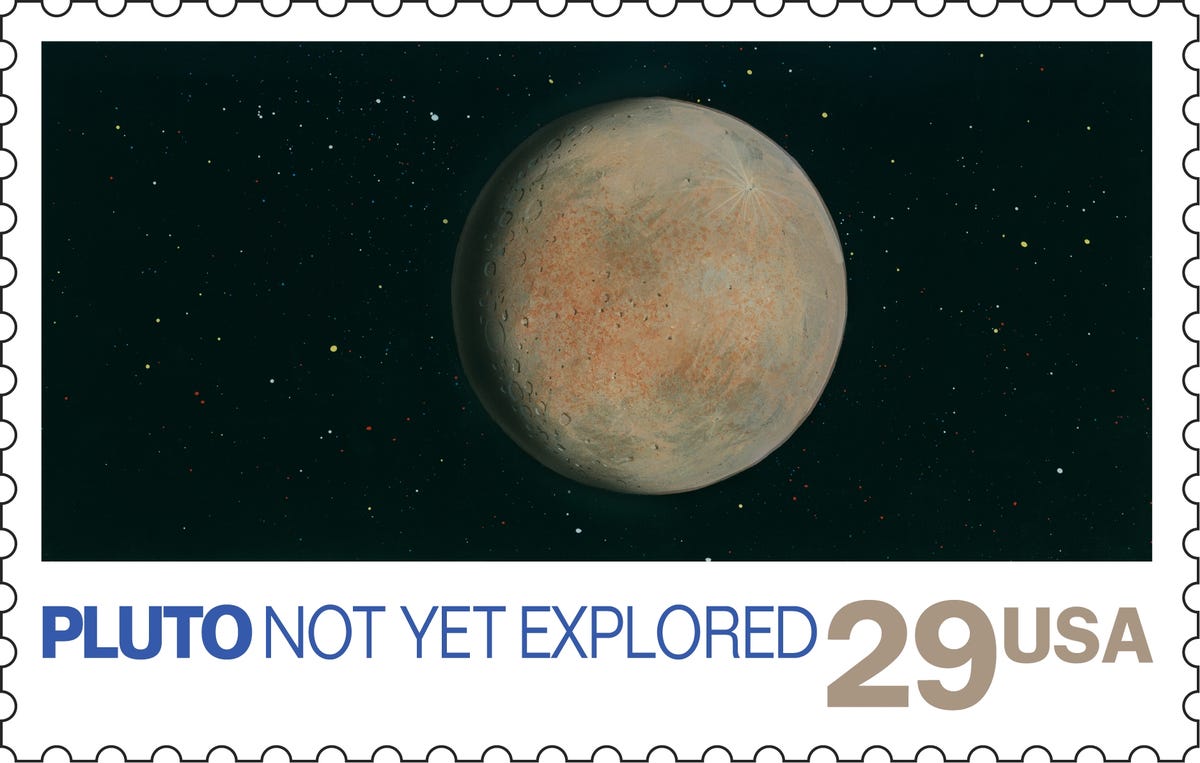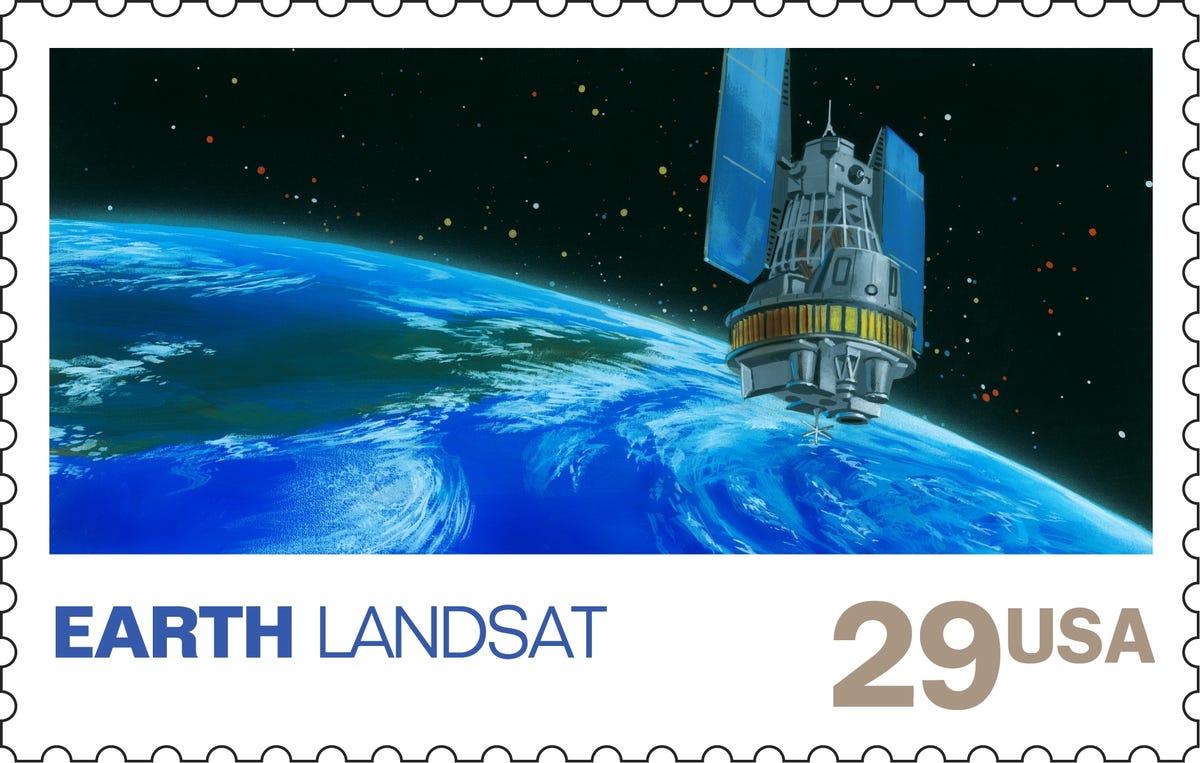Planetary postage: The solar system one stamp at a time (pictures)
While a stamp attached the New Horizons spacecraft is about to make history, the rest of the stamps in the series have some fascinating history to teach us as well.

Pluto
On Tuesday, this postage stamp affixed to the New Horizons spacecraft will become officially outdated. That's because New Horizons will be making its closest approach to the dwarf planet then, effectively changing its status to "explored."
The stamp was created as part of a series issued in 1991 by the United States Postal Service. It included images of all nine planets (nine at the time -- Pluto didn't lose its designation as a planet until 2006). Each stamp showed one of our planets along with one of the spacecraft that had been sent to explore it -- except, of course in the case of Pluto.
New Horizons didn't leave Earth until 2006, the same year the distant planet was downgraded to a minor planet.
Neptune
Launched August 20, 1977, the Voyager 2 spacecraft made its closest approach to Neptune 12 years later, on August 25, 1989. Neptune was its final intended target, although, according to NASA, the spacecraft is still going strong. "Now Voyager 2 is also headed out of the solar system, diving below the ecliptic plane at an angle of about 48 degrees and a rate of about 470 million kilometers (about 292 million miles) a year," says the space agency.
Uranus
Before getting to Neptune, Voyager 2 paid a visit to Uranus in 1986.
The stamps in this series were proposed by Howard Paine, the postal service's art director at the time, and artist Ron Miller, according to the website CollectSpace.
"Paine had been a fan of my first space art book, 'The Grand Tour,' and thought the subject of the planets would make an interesting stamp set," Miller told CollectSpace. "The original idea was to just focus on the worlds themselves. It was only later that spacecraft were added [because] the stamp committee thought there should be an American connection with each planet."
Saturn
Voyager 2 was indeed a busy craft, having also visited Saturn in 1981, a decade before the stamp series was created. As a result, Miller was able to show a few different angles of the satellite on the stamps.
According to NASA, both Voyager 1 and 2 are still hard at work.
"Both spacecraft will continue to study ultraviolet sources among the stars, and their fields and particles detectors will continue to search for the boundary between the Sun's influence and interstellar space," says the space agency. "If all goes well, we will be able to communicate with the two spacecraft for another 20 years, until their radioactive power sources can no longer supply enough electrical energy to power critical subsystems."
Jupiter
On December 3, 1974, Pioneer 11 made its closest approach to Jupiter, traveling faster than any other manmade object had traveled at the time -- 171,000 kilometers per hour (about 106,254 miles per hour).
It followed on the heels of Pioneer 10 and added to the data its predecessor obtained by returning the first images of the planet's polar regions.
The last contact with Pioneer 10 was in 1995. It's now heading out toward the center of our galaxy. Should it ever be found by an alien civilization, it contains a plaque mounted to its struts that shows figures of a man and woman.
Mars
The first Viking mission to Mars launched on August 20, 1975, and the second set off on June 19, 1976. The missions used identical craft, each consisting of a lander and an orbiter.
Here, Miller shows one of the orbiters with the Red Planet in the background.
According to NASA, the combined Viking missions were meant to last for 90 days after the landers touched down. The orbiters and landers went far beyond that though.
"Viking Orbiter 1 continued for four years and 1,489 orbits of Mars, concluding its mission August 7, 1980, while Viking Orbiter 2 functioned until July 25, 1978," says the space agency. "Because of the variations in available sunlight, both landers were powered by radioisotope thermoelectric generators -- devices that create electricity from heat given off by the natural decay of plutonium. That power source allowed long-term science investigations that otherwise would not have been possible."

Earth
There are currently over 1,000 satellites circling our planet, according to the Union of Concerned Scientists' Satellite Database.
There were certainly fewer back in 1991 when this stamp was designed, so for his image of Earth, Miller chose the Landsat 1 satellite to show.
Launched on July 23, 1972, Landsat 1 would be the first in a series of eight satellites to be put in orbit in a program that still exists today with the goal of observing our own planet.
"It was the granddaddy of them all, as far as starting the trend of repetitive, calibrated observations of the Earth at a spatial resolution where one can detect man’s interaction with the environment," Landsat 7 Project Scientist Darrel Williams says on a NASA site about the program.
Venus
Launched in 1962, Mariner 2 was "the first spacecraft to successfully encounter another planet," according to NASA. It was sent after the first mission to Venus -- Mariner 1 -- failed.
Mariner 2 was also the first spacecraft to measure solar wind, a stream of plasma and other particles that blasts from the surface of the sun through our solar system and beyond.
Mercury
Another craft in the Mariner series, Mariner 10 was launched in November 1973 and was the first spaceship to explore Mercury. It also has the distinction of being the first spacecraft to use the gravity of one planet -- in this case, Venus -- to help slingshot it toward another through a process known as gravity assist.
After getting its closest to Mercury in March of 1974, Mariner sent back images and climatic data about the planet. It then looped around the sun and navigated its way back to the planet using the pressure of sunlight on its panels and antenna to help propel and guide it. In this way it acted like an early solar sail, similar to the new LightSail now being developed and tested by the Planetary Society.

